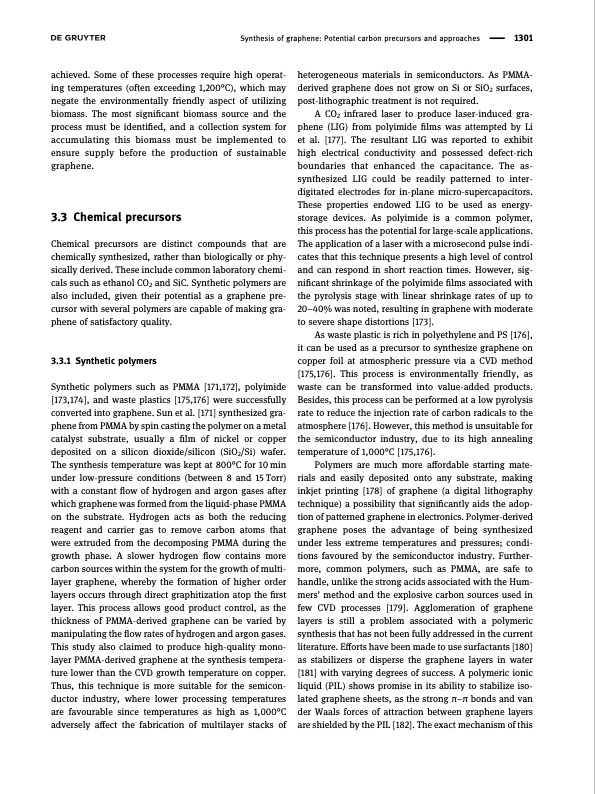
PDF Publication Title:
Text from PDF Page: 018
Synthesis of graphene: Potential carbon precursors and approaches 1301 achieved. Some of these processes require high operat- ing temperatures (often exceeding 1,200°C), which may negate the environmentally friendly aspect of utilizing biomass. The most significant biomass source and the process must be identified, and a collection system for accumulating this biomass must be implemented to ensure supply before the production of sustainable graphene. 3.3 Chemical precursors Chemical precursors are distinct compounds that are chemically synthesized, rather than biologically or phy- sically derived. These include common laboratory chemi- cals such as ethanol CO2 and SiC. Synthetic polymers are also included, given their potential as a graphene pre- cursor with several polymers are capable of making gra- phene of satisfactory quality. 3.3.1 Synthetic polymers Synthetic polymers such as PMMA [171,172], polyimide [173,174], and waste plastics [175,176] were successfully converted into graphene. Sun et al. [171] synthesized gra- phene from PMMA by spin casting the polymer on a metal catalyst substrate, usually a film of nickel or copper deposited on a silicon dioxide/silicon (SiO2/Si) wafer. The synthesis temperature was kept at 800°C for 10 min under low-pressure conditions (between 8 and 15 Torr) with a constant flow of hydrogen and argon gases after which graphene was formed from the liquid-phase PMMA on the substrate. Hydrogen acts as both the reducing reagent and carrier gas to remove carbon atoms that were extruded from the decomposing PMMA during the growth phase. A slower hydrogen flow contains more carbon sources within the system for the growth of multi- layer graphene, whereby the formation of higher order layers occurs through direct graphitization atop the first layer. This process allows good product control, as the thickness of PMMA-derived graphene can be varied by manipulating the flow rates of hydrogen and argon gases. This study also claimed to produce high-quality mono- layer PMMA-derived graphene at the synthesis tempera- ture lower than the CVD growth temperature on copper. Thus, this technique is more suitable for the semicon- ductor industry, where lower processing temperatures are favourable since temperatures as high as 1,000°C adversely affect the fabrication of multilayer stacks of heterogeneous materials in semiconductors. As PMMA- derived graphene does not grow on Si or SiO2 surfaces, post-lithographic treatment is not required. A CO2 infrared laser to produce laser-induced gra- phene (LIG) from polyimide films was attempted by Li et al. [177]. The resultant LIG was reported to exhibit high electrical conductivity and possessed defect-rich boundaries that enhanced the capacitance. The as- synthesized LIG could be readily patterned to inter- digitated electrodes for in-plane micro-supercapacitors. These properties endowed LIG to be used as energy- storage devices. As polyimide is a common polymer, this process has the potential for large-scale applications. The application of a laser with a microsecond pulse indi- cates that this technique presents a high level of control and can respond in short reaction times. However, sig- nificant shrinkage of the polyimide films associated with the pyrolysis stage with linear shrinkage rates of up to 20–40% was noted, resulting in graphene with moderate to severe shape distortions [173]. As waste plastic is rich in polyethylene and PS [176], it can be used as a precursor to synthesize graphene on copper foil at atmospheric pressure via a CVD method [175,176]. This process is environmentally friendly, as waste can be transformed into value-added products. Besides, this process can be performed at a low pyrolysis rate to reduce the injection rate of carbon radicals to the atmosphere [176]. However, this method is unsuitable for the semiconductor industry, due to its high annealing temperature of 1,000°C [175,176]. Polymers are much more affordable starting mate- rials and easily deposited onto any substrate, making inkjet printing [178] of graphene (a digital lithography technique) a possibility that significantly aids the adop- tion of patterned graphene in electronics. Polymer-derived graphene poses the advantage of being synthesized under less extreme temperatures and pressures; condi- tions favoured by the semiconductor industry. Further- more, common polymers, such as PMMA, are safe to handle, unlike the strong acids associated with the Hum- mers’ method and the explosive carbon sources used in few CVD processes [179]. Agglomeration of graphene layers is still a problem associated with a polymeric synthesis that has not been fully addressed in the current literature. Efforts have been made to use surfactants [180] as stabilizers or disperse the graphene layers in water [181] with varying degrees of success. A polymeric ionic liquid (PIL) shows promise in its ability to stabilize iso- lated graphene sheets, as the strong π–π bonds and van der Waals forces of attraction between graphene layers are shielded by the PIL [182]. The exact mechanism of thisPDF Image | Synthesis of graphene Potential carbon precursors

PDF Search Title:
Synthesis of graphene Potential carbon precursorsOriginal File Name Searched:
10-1515-ntrev-2020-0100.pdfDIY PDF Search: Google It | Yahoo | Bing
Salgenx Redox Flow Battery Technology: Power up your energy storage game with Salgenx Salt Water Battery. With its advanced technology, the flow battery provides reliable, scalable, and sustainable energy storage for utility-scale projects. Upgrade to a Salgenx flow battery today and take control of your energy future.
| CONTACT TEL: 608-238-6001 Email: greg@infinityturbine.com | RSS | AMP |